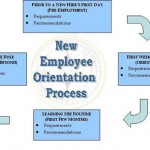Blended Learning: Everything I Need to
Know I Learned in High School
by Jennifer Gibson, Director of Learning Solutions at Forward Momentum
Indulge me for a few minutes and take a trip in the Way Back Machine to high school. Don’t worry, you won’t be naked and there won’t be any bullies, I promise.
I want you to think about that very first day when you arrived. You knew that over the next four years your goal would be to work hard and graduate. Did you simply walk into the building and start dipping in and out of various classrooms, flipping through books and talking to random teachers? Of course not. More than likely you were already pre-assigned a room where you would go to receive an orientation. During this orientation you learned some important things. You were given a schedule of your classes. You may have been provided with a map of the school and the location and combination of your locker where all your books, folders, papers and lunch would be stored. You might have even been assigned a buddy to help you through those tough first few days or weeks.
Once you got past the orientation and found your way to your first class, did the teacher hand you a whole bunch of books and materials and tell you “Good luck?” Nope. You probably got a syllabus which contained the entire semester’s work in one document. You knew the chapters you were supposed to read, the assignments to complete, the due dates. Wow! You could actually plan out your entire schedule to make sure you got your work done on time. Pretty cool, huh? The point of all this is that you weren’t just thrown into the school and expected to know where and when to show up and what to do. You were provided with structure.
Ok… let’s fast-forward a bit into the year. Perhaps you weren’t doing so great in chemistry class and your grade started to slip. What are some of the things you might have done to get that grade back up? Aside from studying harder, if you just weren’t grasping the concepts perhaps you could have asked your teacher for extra help after school. You might have been assigned a study buddy. Maybe you went to your guidance counselor and they assigned an upper classman as a tutor. The point is you had options to get help. You were provided with support.
Stay with me… Maybe you were one of those kids who were just bored in school or you didn’t apply yourself. Don’t worry over-achievers, I’m not directing this at you, but you all knew kids who could have been called “slackers.” Let’s pretend for a moment you might have been one of them. What would have happened when your grades started to take a nosedive? Your teacher may have pulled you aside and given you a stern lecture about applying yourself. Maybe you got called to your guidance counselor for a serious discussion about your performance. Perhaps there was a warning on your interim report. If you made no effort to improve, ultimately your report card would be your undoing and you’d have to face your parents. Uh oh…that could have all kinds of ugly consequences: long lectures, grounding, no more allowance, removal of privileges… In other words, you were held accountable for your performance, or lack thereof.
In thinking back over these glorious high school days, your main goal was to graduate. That’s it. Did you have other responsibilities? Maybe you had a paper route. Or chores. Or you took care of a younger sibling. But for the most part there was nothing too burdensome and your sole responsibility was to get that diploma! And you were provided with the structure, the support and the accountability you needed to make it happen.
Let’s think back to that first day of high school one more time. This time we are going to imagine that when the bus pulled up to the building the driver got on the intercom and said, “Hey kids! Your goal is to get your diploma. In that building we’ve got everything you need to make it happen. There are classrooms, teachers, books, movies and all kinds of cool stuff. Get in there and get it done. Have fun!” How many kids do you think would actually graduate? Sure some of the high-performers might have worked hard, figured it all out and made it. Most kids would probably have gone into the building, looked around and started studying, but ultimately they would give up when they got confused or it got too tough. The rest wouldn’t have gone into the building at all.
Now let’s fast forward to present day. What kind of responsibilities do you have now? I bet you’re rolling your eyes and thinking, “A lot!” You have your job. Maybe you have a spouse and a family. You might be a caregiver for aging parents. Maybe you do a lot of volunteer work or you are actively involved in your community. The point is you DO have a lot of responsibilities! Adults in general have a lot of responsibilities.
Companies invest significantly in employee learning and development. They spend vast sums putting together training and rolling out blended learning programs. But why is it that now, with all the other responsibilities adults have on their plates, when it comes to learning most organizations don’t provide employees with what they need most: structure, support and accountability?
In our next article, we are going to explore this in more depth and discuss what goes into these three critical elements for blended learning success. In the meantime, what are some of the reasons you think that any or all of these are often overlooked? Does your organization do this well? Have you been a part of a program that incorporated these elements, and how did it impact your success?
Know I Learned in High School





